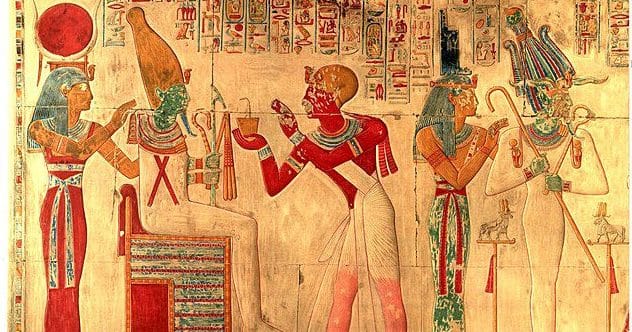Have you ever wondered if there’s more to the story of Jesus and the beginnings of Christianity than what we usually hear? What if some of its deepest roots stretch back to the sands of ancient Egypt? It’s a fascinating thought, and some theories suggest connections that are truly mind-bending. Get ready to explore ten intriguing, and sometimes controversial, links that might just change how you see religious history.
The Alpha Omega in the King’s Chamber
Imagine stumbling upon a secret hidden for centuries! In 2018, researcher Robert E. Grant found the Greek symbols Alpha and Omega on the sarcophagus in the Great Pyramid’s King’s Chamber. What’s so startling? These symbols, marking the beginning and the end, are incredibly important in Christianity, often representing Jesus or God.
Grant mentioned a strange flash of insight led him to the discovery, almost as if a whisper from the past guided his eyes. He believes this find connects Jesus directly to ancient Egyptian culture. Even more, it could mean the Greek alphabet itself came from an older, lost civilization that influenced both Egypt and Mesopotamia. It’s a discovery that makes you wonder what other secrets are waiting to be found.
Jesus Learned in the Egyptian Mystery Schools
It’s widely thought that Jesus spent a couple of years studying in the mystery schools of Heliopolis, soaking up ancient Egyptian wisdom from their priests. What exactly did he learn? While we don’t know for sure, it’s likely he delved into the movements of stars and planets, and perhaps complex initiation rituals, maybe even similar to what modern Freemasons practice.
Some scholars suggest that Jesus later used this hidden knowledge in his teachings, sharing it only with those who understood its depth. The raising of Lazarus, for instance, is sometimes seen as one of these special rituals learned in Egypt. Interestingly, Heliopolis was a major center for worshipping Ra, the sun god. As we’ll see, sun worship is another thread connecting Christianity and ancient Egypt. But why was Jesus in these schools to begin with? That leads us to our next point.
He Was an Egyptian Prince (by Descent)
Could Jesus have been more than just a teacher? Some researchers propose a truly startling idea: Jesus was of Egyptian heritage, possibly a prince or a Pharaoh in waiting. The theory suggests he came from a wealthy Egyptian family with a legitimate claim to the throne.
There are subtle hints in biblical texts about Jesus’ potentially high status. Think about the wedding at Cana. Some interpret his mother asking him to provide more wine as a sign it was his wedding, as it was customary for the host to supply food and drink. Then there’s Joseph of Arimathea, reportedly Jesus’ uncle, who was a man of considerable wealth and influence, respected by both Jewish priests and Roman authorities. If true, this connection to a pharaonic line makes his time in Egyptian mystery schools even more logical.
The Shepherd Kings: The Hyksos
For a long time, historians thought the Hyksos kings, also known as the Shepherd Kings, were foreign invaders who ruled Lower Egypt from roughly 1638 BC to 1530 BC. However, new research suggests they might not have been foreigners at all. Instead, they could have been Egyptians from the north who rose up against Upper Egypt.
Researcher Ralph Ellis has a fascinating take: he believes the Hyksos were actually high priests and Egyptian royalty. Their break from Upper Egypt might have been over a shift in astrological beliefs – moving from the age of Taurus (worshipping the bull) to Aries (worshipping the ram or sheep). This focus on sheep could be why they were called Shepherd Kings. Remember, Jesus himself is often referred to as a shepherd.
Eventually, the Hyksos were overthrown, and some theories connect this event to the legends of the Exodus. It’s even suggested that figures like Aaron and Moses were actually Egyptian royalty. After arriving in Jerusalem, they sought to rebuild, all while keeping the secret teachings of ancient Egypt alive. This, some say, was the beginning of the Hebrew people, who later tried to hide their Egyptian connections in their historical writings.
Bizarre Claims of Sorcery
Here’s a truly unusual connection: ancient writings that describe Jesus as a sorcerer, skilled in the ways of Egyptian high priests. Some texts even claim he was a shapeshifter! It sounds like something out of a fantasy novel, doesn’t it?
An ancient Egyptian text, found in the early 2000s, apparently describes Jesus’ crucifixion but also mentions his “ability to change shape” and that “his appearance changes.” Whether these texts should be taken literally is up for debate. However, the very fact that Jesus is mentioned in ancient Egyptian writings strengthens the link between these two seemingly separate worlds.
Could these claims of sorcery actually be references to the profound wisdom he gained in the Egyptian mystery schools? And was this why his activities were so carefully noted by some?
The Horus Legends
One of the most debated theories is that the story of Jesus is, in essence, a retelling of the story of the ancient Egyptian god Horus. This is a big claim, and understandably, many contest it. Yet, the parallels are striking and once again tie Jesus and early Christianity to ancient Egyptian beliefs.
Consider these similarities: both Horus and Jesus are said to have had twelve disciples. Both reportedly walked on water and performed miracles. Both were said to have been executed alongside two thieves. Even more captivating, both were believed to have risen after death and ascended to the heavens. Could it be that when the New Testament was being formed, the life of Jesus was woven with Horus’s story? Perhaps it was a subtle nod to his Egyptian origins for those “in the know,” while remaining hidden from the wider population.
Multiple Ancient Writings and Belief Systems
It’s not just the Horus legends that show common themes with the story of Jesus. Core elements of Christian creation stories and beliefs can be found in many other cultures worldwide, often predating Christianity by thousands of years – including, of course, ancient Egypt.
One of the most compelling parallels is the belief in an afterlife, shared by both ancient Egyptians and Christians. The idea of being judged by a divine power after death resonates strongly in both traditions. Similarly, concepts of Hell in Christianity mirror the ancient Egyptian underworld, known as Duat. It almost seems as if these ancient Egyptian belief systems have subtly survived through time, perhaps disguised within Christian teachings. Could these beliefs trace back even further, to a lost, globally influential civilization whose impact we still feel today?
The Divine Nature of Kings
Another intriguing link between Jesus, Christianity, and ancient Egypt lies in the concept of divinity. In Christian theology, Jesus is simultaneously God and human. Remember those ancient Egyptian texts claiming Jesus had “more than one form”? Could this have been an early reference to what we now understand as Jesus’ divine nature?
It’s fascinating to note that the pharaohs of ancient Egypt were viewed in a similar light. They were considered both human and the incarnation of the god Horus – the same Horus whose legends share so many similarities with Jesus’ story. The fact that both Jesus and the Egyptian pharaohs were regarded as being both human and god-like at the same time is a remarkable parallel. Could this be yet another subtle clue pointing to the real-life Jesus’ true identity and status, perhaps linking him to Egyptian royalty?
Sun Worship
The connections between sun worship, Jesus, and Christianity are numerous and deep. This also ties into Atenism, a temporary ancient Egyptian belief system where the Aten, or sun disk, was the supreme deity. Some researchers even suggest that this sudden shift to monotheistic sun worship was a root cause of the Exodus.
Is it possible that sun worship continued, albeit secretly, after those who left Egypt arrived in Jerusalem? And could this be why the biblical story of Jesus seems to hold allegories for the sun? It’s worth noting that Jesus often spoke in parables, with layers of meaning understood by only a select few, while the masses heard something different. Many assert that by the time modern Christianity was formalized, particularly after the Council of Nicaea, only an inner circle knew they were subtly continuing ancient sun god traditions. Most people, however, believed they were worshipping Jesus, the Son of God.
Was Mary Magdalene Jesus’ Wife and Sister?
Perhaps the most controversial claim linking Jesus, and by extension Christianity, to ancient Egypt revolves around Mary Magdalene. Some theories propose that she was not only Jesus’ wife but also his sister. This is a radical idea that challenges many traditional beliefs.
Researcher Ralph Ellis is a prominent voice for these suggestions, claiming in several books that Mary Magdalene was actually Mary of Bethany, which would also make Lazarus Jesus’ brother. Why would such significant facts be covered up? Some believe it was a deliberate effort to erase any connections to Jesus’ ancient Egyptian origins. In ancient Egypt, it was common, even expected, for a pharaoh to marry his sister to maintain the purity of the royal bloodline. If there’s any truth to the claims that Mary Magdalene was Jesus’ sister, it strongly suggests that the historical Jesus might indeed have been an Egyptian pharaoh by descent.
Exploring these ten potential connections between Jesus, Christianity, and ancient Egypt certainly opens up a world of questions and alternative perspectives. From symbolic discoveries in pyramids to parallels in divine narratives and royal customs, these ideas, though often debated, invite us to look beyond traditional interpretations. Whether you see them as compelling evidence or fascinating speculation, they highlight the rich and often mysterious tapestry of history that continues to influence our understanding of faith and the past. It reminds us that history is not always set in stone and that new discoveries can reshape what we thought we knew.
What do you think about these connections? Do any of them particularly intrigue or surprise you? Share your thoughts and join the conversation in the comments below!










